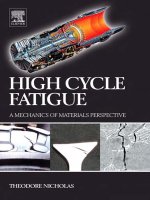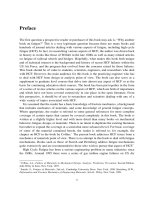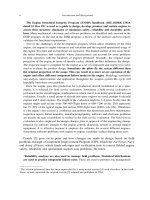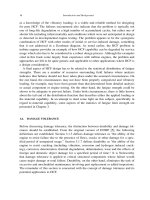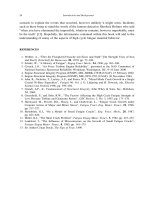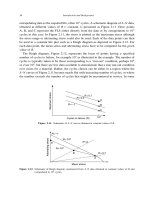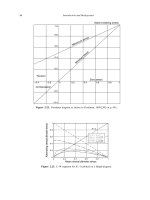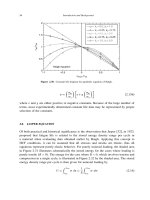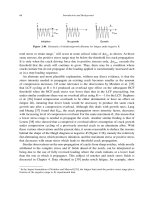High Cycle Fatigue: A Mechanics of Materials Perspective part 1 docx
Bạn đang xem bản rút gọn của tài liệu. Xem và tải ngay bản đầy đủ của tài liệu tại đây (302.95 KB, 10 trang )
High Cycle Fatigue
A Mechanics of Materials Perspective
This page intentionally left blank
High Cycle Fatigue
A Mechanics of Materials
Perspective
Theodore Nicholas
Air Force Institute of Technology
Department of Aeronautics and Astronautics
Wright Patterson AFB, Ohio, USA
AMSTERDAM
•
BOSTON
•
HEIDELBERG
•
LONDON
•
NEW YORK
•
OXFORD
PARIS
•
SAN DIEGO
•
SAN FRANCISCO
•
SINGAPORE
•
SYDNEY
•
TOKYO
Elsevier Ltd. Elsevier B.V. Elsevier Inc., Elsevier Ltd.
The Boulevard, Langford Lane Radarweg 29 525 B Street, Suite 1900 84 Theobalds Road
Kidlington, Oxford
OX5 1GB
P.O. Box 211, 1000 AE
Amsterdam
San Diego,
CA 92101-4495
London
WC1Z 8RR
UK The Netherlands USA UK
© 2006 Elsevier Ltd. All rights reserved.
This work is protected under copyright by Elsevier Ltd, and the following terms and conditions apply to its use:
Photocopying
Single photocopies of single chapters may be made for personal use as allowed by national copyright laws. Permission
of the Publisher and payment of a fee is required for all other photocopying, including multiple or systematic copying,
copying for advertising or promotional purposes, resale, and all forms of document delivery. Special rates are available
for educational institutions that wish to make photocopies for non-profit educational classroom use.
Permissions may be sought directly from Elsevier’s Rights Department in Oxford, UK: phone (+44) (0) 1865 843830;
fax (+44) (0) 1865 853333, e-mail: Requests may also be completed on-line via the Elsevier
homepage ( />In the USA, users may clear permissions and make payments through the Copyright Clearance Center, Inc., 222 Rose-
wood Drive, Danvers, MA 01923, USA; phone: (+1)(978) 7508400, fax: (+1)(978) 7504744, and in the UK through
the Copyright Licensing Agency Rapid Clearance Service (CLARCS), 90 Tottenham Court Road, London W1P 0LP,
UK; phone: (+44) 20 7631 5555; fax: (+44) 20 7631 5500. Other countries may have a local reprographic rights
agency for payments.
Derivative Works
Tables of contents may be reproduced for internal circulation, but permission of the Publisher is required for external
resale or distribution of such material. Permission of the Publisher is required for all other derivative works, including
compilations and translations.
Electronic Storage or Usage
Permission of the Publisher is required to store or use electronically any material contained in this work, including any
chapter or part of a chapter.
Except as outlined above, no part of this work may be reproduced, stored in a retrieval system or transmitted in any
form or by any means, electronic, mechanical, photocopying, recording or otherwise, without prior written permission
of the Publisher.
Address permissions requests to: Elsevier’s Rights Department, at the fax and e-mail addresses noted above.
Notice
No responsibility is assumed by the Publisher for any injury and/or damage to persons or property as a matter of
products liability, negligence or otherwise, or from any use or operation of any methods, products, instructions or
ideas contained in the material herein. Because of rapid advances in the medical sciences, in particular, independent
verification of diagnoses and drug dosages should be made.
First edition 2006
ISBN–13: 978-0-08-044691-2
ISBN–10: 0-08-044691-4
The paper used in this publication meets the requirements of ANSI/NISO Z39.48-1992 (Permanence of Paper).
Printed in Great Britain
0607080910 10987654321
Working together to grow
libraries in developing countries
www.elsevier.com | www.bookaid.org | www.sabre.org
Contents
Preface x
Part One Introduction and Background 1
1 Introduction 3
1.1 Historical background 3
1.2 What is High Cycle Fatigue? 4
1.3 HCF design considerations 5
1.4 HCF design requirements 9
1.5 Root causes of HCF 11
1.5.1 Field failures 13
1.6 Damage tolerance 16
1.6.1 Application to HCF 20
1.7 Current status 23
1.8 Field experience 25
2 Characterizing Fatigue Limits 27
2.1 Constant life diagrams 27
2.2 Gigacycle fatigue 27
2.3 Characterizing fatigue cycles 34
2.4 Fatigue limit stresses 35
2.5 Equations for constant life diagrams 41
2.6 Haigh diagram at elevated temperature 47
2.7 Role of mean stress in constant life diagrams 51
2.8 Jasper equation 56
2.9 Observations on step tests at negative R 65
3 Accelerated Test Techniques 70
3.1 Historical background 70
3.1.1 Coaxing 70
3.2 Early test methods 72
3.3 Step test procedures 75
3.3.1 Statistical considerations 76
3.3.2 Influence of number of steps 78
3.3.3 Validation of the step-test procedure 80
3.3.4 Observations from the last loading block 85
3.3.5 Comments on step testing 89
3.4 Staircase testing 90
3.4.1 Probability plots 91
v
vi Contents
3.4.2 Statistical analysis 95
3.4.2.1 Dixon and Mood method 95
3.4.2.2 Numerical simulations 99
3.4.2.3 Sample size considerations 104
3.4.2.4 Construction of an “artificial” staircase 105
3.5 Other methods 106
3.6 Random fatigue limit (RFL) model 109
3.6.1 Data analysis 113
3.7 Summary comments on FLS statistics 120
3.8 Constant stress tests 123
3.8.1 Run-outs and maximum likelihood (ML) methods 126
3.9 Resonance testing techniques 129
3.10 Frequency effects 134
Part Two Effects of Damage on HCF Properties 143
4 LCF–HCF Interactions 145
4.1 Small cracks and the Kitagawa diagram 145
4.1.1 Behavior of notched specimens 149
4.2 Effects of LCF loading on HCF limit stress 153
4.2.1 Studies of naturally initiated LCF cracks 170
4.3 Crack-propagation thresholds 170
4.3.1 Overloads and load-history effects 172
4.3.1.1 An overload model 180
4.3.1.2 Analysis using an overload model 182
4.3.2 Examples of LCF–HCF interactions 183
4.4 Design considerations 193
4.4.1 LCF–HCF nomenclature 196
4.4.2 Example of anomalous behavior 197
4.4.3 Another example of anomalous behavior 200
4.5 Combined cycle fatigue case studies 204
5 Notch Fatigue 213
5.1 Introduction 213
5.2 Stress concentration factor 213
5.3 What is k
t
? 215
5.4 Fatigue notch factor 216
5.4.1 k
f
versus k
t
relations 217
5.4.2 Equations for k
f
218
5.5 Fracture mechanics approaches for sharp notches 222
5.6 Cracks versus notches 225
5.7 Mean stress considerations 228
5.8 Plasticity considerations 232
5.8.1 Negative mean stresses 238
Contents vii
5.9 Fatigue limit strength of notched components 239
5.9.1 Non-damaging notches 241
5.10 Size effects and stress gradients 242
5.10.1 Critical distance approaches 242
5.11 Analysis methods 246
5.12 Effects of defects on fatigue strength 251
5.13 Notch fatigue at elevated temperature 254
6 Fretting Fatigue 261
6.1 Introduction 261
6.2 Observations of fretting fatigue 263
6.3 Representing total contact loads, Q and P 267
6.4 Load and stress distributions 271
6.5 Effects of local and bulk stresses on stress intensity 272
6.6 Mechanisms of fretting fatigue 277
6.7 Mechanics of fretting fatigue 279
6.8 Stress analysis of contact regions 281
6.8.1 Multiple crack considerations 283
6.8.2 Analytical solutions 284
6.9 Role of slip amplitude 292
6.10 Stress-at-a-point approaches 295
6.11 Fracture mechanics approaches 300
6.12 A combined stress and K approach 306
6.13 Comparison of fretting-fatigue fixtures 309
6.14 Role of coefficient of friction 312
6.14.1 Average versus local coefficient of friction 317
6.15 Summary comments 317
7 Foreign Object Damage 322
7.1 Introduction 322
7.2 Field experience and observations 324
7.3 Repair by blending 325
7.4 Background 326
7.5 FOD data mining and investigation 326
7.6 Definition of FOD 328
7.7 Types of damage 329
7.8 Scope of the FOD problem 336
7.8.1 Laboratory simulation methods 338
7.8.1.1 Solenoid gun 338
7.8.1.2 Pendulum 338
7.8.1.3 Quasi-static 339
7.8.2 Simulations using a leading edge geometry 339
7.8.3 Role of residual stresses 344
7.8.4 Energy considerations 345
viii Contents
7.9 Fatigue limit strength 347
7.9.1 Simulations using a flat plate 352
7.9.2 Other laboratory FOD simulations 359
7.10 Analytical modeling of FOD 368
7.10.1 Perturbation study 371
7.11 Summary comments 374
Part Three Applications 377
8 HCF Design Considerations 379
8.1 Factors of safety 379
8.1.1 Modeling errors 381
8.1.2 Material variability 384
8.2 Fracture mechanics considerations 386
8.2.1 Effects of defects 390
8.2.2 Application to LCF–HCF 396
8.3 Damage tolerance for HCF 398
8.3.1 Material allowables 400
8.4 Threshold concept for HCF 403
8.4.1 Representing fatigue limit data 405
8.4.2 Threshold considerations 408
8.4.3 Experimental threshold measurements 409
8.4.3.1 “Jump-in” method 409
8.4.4 Mechanisms in threshold testing 412
8.4.5 Load-history effects 414
8.4.5.1 Compression precracking 416
8.4.5.2 Load-shed rates 416
8.4.6 Crack closure 418
8.4.6.1 K
max
−K concept 419
8.4.6.2 Crack propagation stress intensity factor 422
8.4.7 An engineering approach to thresholds 423
8.4.8 Observations from field failures 424
8.5 Probabilistic approach to HCF/FOD design 425
8.6 Residual stresses in HCF design 430
8.6.1 Application to notches 436
8.6.2 Shot peening 441
8.6.3 Deep residual stresses 447
8.6.3.1 Application to an airfoil geometry 449
8.6.3.2 Crack arrest 458
8.6.3.3 Crack growth retardation 461
8.6.3.4 A numerical example 462
8.6.4 Autofrettage 464
Contents ix
Appendices
A. Early Railroad Accidents and the Origins of Research on Fatigue of
Metals 472
George P. Sendeckyj
B. Final Report for the USAF High Cycle Fatigue Program 493
Otha Davenport
C. HCF in ENSIP 499
D. Evaluation of the Staircase Test Method using Numerical Simulation 517
Major Randall Pollak
E. Estimation of HCF Threshold Stress Levels in Notched Components 531
Alan Kallmeyer
F. Analytical Modeling of Contact Stresses 542
Bence B. Bartha, Narayan K. Sundaram and Thomas N. Farris
G. Experimental and Analytical Simulation of FOD 558
Jeffrey Calcaterra
H. FOD in JSSG 600
I. Computation of High Cycle Fatigue Design Limits under Combined
High and Low Cycle Fatigue 617
Joseph R. Zuiker
Index 639

